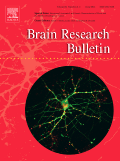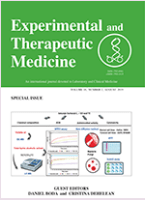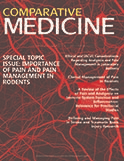
Animal Models and Experimental Medicine
Scope & Guideline
Unlocking new frontiers in biomedical exploration.
Introduction
Aims and Scopes
- Development and validation of animal models:
The journal emphasizes the creation and refinement of animal models that accurately mimic human diseases, enabling researchers to investigate pathophysiological mechanisms and test therapeutic interventions. - Preclinical studies for drug development:
It publishes research that explores the efficacy and safety of new pharmaceuticals through preclinical trials in various animal models, providing critical insights before clinical applications. - Interdisciplinary approaches in experimental medicine:
The journal encourages interdisciplinary research that integrates insights from genetics, molecular biology, pharmacology, and epidemiology to enhance the understanding of disease mechanisms and treatment outcomes. - Ethical considerations in animal research:
A core theme is the ethical implications of using animal models in research, promoting humane practices and the 3Rs (Replacement, Reduction, Refinement) in experimental designs. - Focus on translational research:
The journal aims to bridge the gap between laboratory findings and clinical applications, facilitating the translation of discoveries into therapeutic strategies for human health.
Trending and Emerging
- Humanized animal models:
There is a growing interest in the development of humanized animal models that better mimic human immune responses and disease manifestations, particularly for studying complex conditions like cancer and infectious diseases. - Microbiome research:
Studies focusing on the interactions between animal models and their microbiomes are increasingly prevalent, highlighting the role of gut microbiota in health and disease. - Advanced imaging techniques:
The integration of advanced imaging modalities in animal studies is on the rise, enabling real-time monitoring of disease progression and treatment responses. - Regenerative medicine and stem cell applications:
Research exploring the use of stem cells and regenerative medicine techniques in various animal models is becoming more prominent, showcasing innovative approaches to tissue repair and disease management. - Personalized medicine approaches:
There is an emerging focus on using animal models to study personalized medicine, investigating how individual genetic and phenotypic variations can affect treatment outcomes.
Declining or Waning
- Traditional disease models:
There has been a noticeable decrease in studies focused solely on classical animal models, such as those for diabetes and obesity, as newer methodologies and computational models gain traction. - Basic mechanistic studies without therapeutic implications:
Research that solely explores basic mechanisms of disease without linking findings to potential therapeutic applications appears to be waning, as the journal increasingly prioritizes studies with direct translational relevance. - Single-species animal studies:
The use of single-species models has declined in favor of studies employing comparative approaches or multi-species models that may provide broader insights into disease processes. - Historical perspectives on animal models:
Papers providing retrospective analyses of animal model development have become less frequent, suggesting a move towards more forward-looking research that emphasizes innovation and practical applications.
Similar Journals

BRAIN RESEARCH BULLETIN
Shaping the future of neuroscience through impactful research.BRAIN RESEARCH BULLETIN is a leading academic journal published by PERGAMON-ELSEVIER SCIENCE LTD, dedicated to the dissemination of high-quality research in the interdisciplinary field of neuroscience. Since its inception in 1976, this journal has served as a vital platform for researchers, professionals, and students interested in a broad spectrum of topics within neuroscience, making significant contributions to the understanding of brain function and its associated disorders. With a commendable impact factor and a current Scopus rank of #35 out of 113 in general neuroscience, the journal holds a Q2 quartile ranking, underscoring its relevance and influence in the academic community. BRAIN RESEARCH BULLETIN invites submissions of original articles, reviews, and brief communications, enhancing scholarly communication within this dynamic field. Although the journal is not open access, it ensures widespread reach and impact through various subscription models, allowing access to pivotal findings that pave the way for future research advancements. For researchers aiming to share impactful discoveries and insights within the neuroscience community, BRAIN RESEARCH BULLETIN remains an essential outlet.

JOURNAL OF PHYSIOLOGY AND PHARMACOLOGY
Exploring the intersections of life sciences and medicine.JOURNAL OF PHYSIOLOGY AND PHARMACOLOGY is a distinguished publication presented by the POLISH PHYSIOLOGICAL SOC, dedicated to advancing the fields of physiology and pharmacology. Since its inception in 1991, this journal has maintained a commitment to disseminating vital research findings, contributing to the growing body of knowledge essential for understanding complex biological systems and their interactions with pharmacological agents. With a consistent focus on interdisciplinary studies, the journal holds a Q3 categorization in both Medicine and Pharmacology as well as Physiology for 2023, reflecting its relevance in these crucial fields. Although specific access options are not available, the journal's robust indexing and rankings in Scopus signify its credibility and the high caliber of its contributions, appealing to researchers, professionals, and students alike. Operating from the picturesque Jagiellonian University in Krakow, Poland, this journal not only enriches the academic landscape but also fosters global collaboration and innovation in the life sciences.

Experimental and Therapeutic Medicine
Unveiling the future of healthcare through innovative research.Experimental and Therapeutic Medicine is a distinguished peer-reviewed journal published by SPANDIDOS PUBL LTD, focusing on the dynamic fields of Immunology, Microbiology, and Cancer Research. With its ISSN 1792-0981 and E-ISSN 1792-1015, this journal holds a notable position in the research community, contributing valuable insights into experimental methodologies and therapeutic strategies that advance understanding in these critical areas. Although the journal's coverage in Scopus was discontinued after 2018, it continues to serve as a resource for emerging studies and novel discoveries, evidenced by its ranking within the 37th percentile in Immunology and Microbiology, and the 17th percentile in Cancer Research. Researchers, professionals, and students alike can benefit from its rigorous articles and comprehensive reviews, further enhancing their comprehension of the vibrant landscape of modern medicine. Explore this journal to discover pivotal findings that shape the future of healthcare.

Physiology and Pharmacology
Exploring the frontiers of biological systems and drug action.Physiology and Pharmacology is a distinguished open access journal that has been disseminating high-quality research in the fields of physiology and pharmacology since its inception in 1997. Published by the Iranian Society of Physiology & Pharmacology, this journal offers a platform for scholars and practitioners to share innovative findings and advancements that contribute to the understanding of biological systems and drug action. With its ISSN 2476-5236 and E-ISSN 2476-5244, it ensures global reach and accessibility. The journal is positioned in the third quartile for Linguistics and Language and fourth quartile in both Pharmacology and Physiology categories according to Scopus rankings, reflecting a commitment to expanding knowledge within these interdisciplinary domains. Set within the academic landscape of Iran, the journal aims to bridge regional research with the international community, providing valuable insights into physiological processes and pharmacological developments. In light of its open access model, the Physiology and Pharmacology journal plays a crucial role in enhancing the visibility of research outcomes and fostering collaboration among researchers, professionals, and students on a global scale.

AMERICAN JOURNAL OF VETERINARY RESEARCH
Elevating Animal Welfare Through Scholarly ContributionsAmerican Journal of Veterinary Research, published by the American Veterinary Medical Association, serves as a cornerstone of the veterinary medical community, providing essential insights from 1945 to the present. With an ISSN of 0002-9645 and E-ISSN of 1943-5681, this esteemed journal focuses on a diverse range of topics within the veterinary field, contributing to the advancement of veterinary science through rigorous peer-reviewed research. Ranking in the Q2 category in Veterinary (miscellaneous) and Q3 in Medicine (miscellaneous) category as of 2023, it holds a respectable position in Scopus rankings, further emphasizing its impact in the field. While currently not an Open Access journal, its objective remains clear: to disseminate cutting-edge research that informs clinical practice and enhances animal health and welfare. The American Journal of Veterinary Research is invaluable for researchers, professionals, and students seeking to stay at the forefront of veterinary advancements and innovations.

COMPARATIVE MEDICINE
Fostering dialogue in the realm of comparative medicine.Comparative Medicine, published by the American Association for Laboratory Animal Science, serves as a vital resource in the fields of veterinary science and biochemistry, focusing on the complexities of laboratory animal research and its implications for human and animal health. Established in 2000 and continuing through 2024, this journal has cultivated a reputation for disseminating innovative research and reviews that enhance understanding of comparative biology and medicine. With a commendable Q3 rank in both Biochemistry, Genetics and Molecular Biology and Medicine, and a notable Q2 rank in Veterinary sciences as of 2023, it stands out in its field. The journal is dedicated to open access, aligning with contemporary trends in scientific communication, and its impact can be appreciated in its Scopus ranks, placing it in the 59th percentile for General Veterinary and the 36th percentile for General Biochemistry, Genetics, and Molecular Biology. Researchers, professionals, and students will find this journal indispensable for staying informed on cutting-edge advancements and fostering cross-disciplinary dialogue in comparative medicine.

BIOMEDICAL PAPERS-OLOMOUC
Empowering discoveries through open-access research.BIOMEDICAL PAPERS-OLOMOUC, published by Palacky University Medical Faculty, is a prominent open-access journal dedicated to advancing the fields of biochemistry, genetics, molecular biology, and general medicine. Since its inception in 2001, this journal has provided a vital platform for researchers, professionals, and students alike, fostering a collaborative environment for the dissemination of cutting-edge research findings. With a current impact factor reflected in its placement in the Q3 quartiles for both biochemistry and medicine categories, it demonstrates a growing influence in the academic community. The journal is indexed in Scopus, showcasing its relevance within the medical and biophysical sciences, and it operates in an open-access format to ensure broad accessibility of its articles. Set against the backdrop of Olomouc, Czech Republic, BIOMEDICAL PAPERS-OLOMOUC continues to contribute significantly to the global dialogue in biomedical research, making it an essential resource for anyone engaged in these dynamic and rapidly evolving fields.

KOREAN JOURNAL OF PHYSIOLOGY & PHARMACOLOGY
Connecting researchers and professionals in the heart of pharmacology.Welcome to the Korean Journal of Physiology & Pharmacology, a pivotal academic platform dedicated to advancing the disciplines of physiology and pharmacology. Published by the esteemed Korean Journal of Physiology & Pharmacology, this journal has been disseminating valuable research findings since its inception in 1997 and continues to be a critical resource for researchers, professionals, and students in South Korea and beyond. With an ISSN of 1226-4512 and E-ISSN of 2093-3827, it offers insights into various aspects of drug action and physiological mechanisms. Although this journal currently does not subscribe to Open Access, it plays a vital role in bridging the gap between experimental and clinical studies, receiving commendations for its quality. In the 2023 Scopus rankings, it is notably positioned in the Q3 quartile for Pharmacology and Q4 for Physiology, reflecting its commitment to excellence. As the journal converges towards its comprehensive coverage in 2024, it remains a cornerstone for those looking to engage deeply with critical developments in these fields.

INTERNATIONAL JOURNAL OF EXPERIMENTAL PATHOLOGY
Advancing Knowledge in Experimental PathologyINTERNATIONAL JOURNAL OF EXPERIMENTAL PATHOLOGY, published by Wiley, is a leading peer-reviewed journal dedicated to the field of experimental pathology. With an ISSN of 0959-9673 and E-ISSN 1365-2613, the journal has been a vital resource for researchers and professionals since its inception in 1990, covering a broad spectrum of topics within pathology, cell biology, and molecular biology. The journal's relevancy is underscored by its Q2 ranking in Pathology and Forensic Medicine and Q3 rankings in both Cell Biology and Molecular Biology, as of 2023, reflecting its significant contribution to the scientific community. Although it does not currently offer open access options, readers can benefit from its insightful research articles and reviews that guide advancements in diagnostic pathology and therapeutic strategies. As the journal continues to evolve, it remains committed to facilitating the exchange of innovative ideas and findings that drive progress in experimental pathology and related fields, making it an indispensable platform for scientists, clinicians, and students alike.

New Armenian Medical Journal
Innovating Healthcare Insights for a Better Tomorrow.New Armenian Medical Journal (ISSN: 1829-0825, E-ISSN: 1829-0825) is a prominent academic publication established by Yerevan State Medical University, dedicated to advancing the field of medicine through high-quality research and scholarly discourse. Located in Armenia, this journal serves as a vital platform for disseminating innovative findings and clinical practices, with a particular focus on the regional healthcare landscape as well as global health issues. While currently categorized in the lower quartile (Q4) of general medicine, it demonstrates a commitment to improving its impact factor and ranking, evidenced by its ongoing publication from 2009 to 2024. The journal embraces a diverse scope that encompasses miscellaneous topics within medical research, catering to the needs of practitioners, researchers, and students alike. Though not an open-access journal, it offers valuable insights and knowledge that contribute meaningfully to the medical community. By participating in this scholarly dialogue, readers can enhance their understanding and foster advancements in the ever-evolving field of medicine.